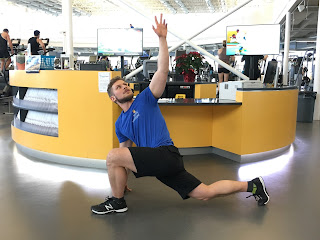Static vs Dynamic Stretching: When should you do each? Do you need both?
by Adam Toffan, M.Sc, NSCA-CSCS, CSEP-CEP
Assistant Fitness Testing and Assessment Coordinator
Recreation Services
University of Manitoba
When to do each
Assistant Fitness Testing and Assessment Coordinator
Recreation Services
University of Manitoba
What
is Static/Dynamic stretching?
For years static stretching was all anyone
did. Recently, many have said you should only do dynamic stretches. Should you
do one over the other? Should you do both? Static stretching is holding a
position for a prolonged period of time. The goal is to relax the muscle while
stretching it. Research found that holding static stretches for ~30s was
sufficient to elongate the muscle and improve flexibility. This helps you
improve mobility for daily activities such as putting on your socks. It can
also help prevent injury by increasing the range a joint can move through
before muscle damage occurs. This type of stretching is most beneficial after a
workout to help cooldown and prevent muscle tightening that occurs after
activity. If flexibility is an issue you may need to add more stretching into
your day, stretching on the floor at home during your leisure time, if
necessary.
Dynamic stretching, on the other hand is
active stretching. Dynamic stretching uses controlled repetitive movements
through the full range of motion and can stretch multiple muscles at a time. A
higher intensity progression to dynamic stretching would include
ballistic/bouncing stretches. When doing dynamic stretches it is important to
progress properly from lower to higher intensity. Dynamic stretching helps
improve blood flow, increase range of motion, improve joint position awareness
and will improve athletic performance. It has become a necessary part of an
athletic warm up.
When to do each
Many still do static stretches as a warm up
out of habit. However, dynamic stretching is a better option when preparing for
activity. The goal of warm up is in its name. You are trying to get warm and
increase the core body temperature. Sitting or standing still holding a stretch
will not be effective at achieving this goal. Actively moving through a range
of motion, even slowly and controlled, will be a more productive use of time.
Moving through the range of motion also helps prepare you for activity by
increasing the release of synovial fluids into the joints to lubricate the
joints. There is also research that shows static stretching reduces muscular
power when done prior to exercise by inhibiting the muscle’s ability to fire
efficiently. Therefore, when warming up for exercise or looking to maximize
athletic performance, dynamic stretching is the way to go.
The benefit of static stretching is
flexibility. When done only prior to activity, you may be wasting your time.
After exercise, you often get tight muscles and this might undo all of your
static stretching in warm up. Static stretching should be reserved for after
exercise and can also be done on its own. This will help prevent tightness post
workout and improve flexibility during daily tasks.
Both forms of stretching have their
benefits and ideal times to be implemented. Depending on your needs and goals
you may use both or you may focus more on one. Whichever you do, consider the
ideal time and purpose of each to maximize your results!




Comments
Post a Comment